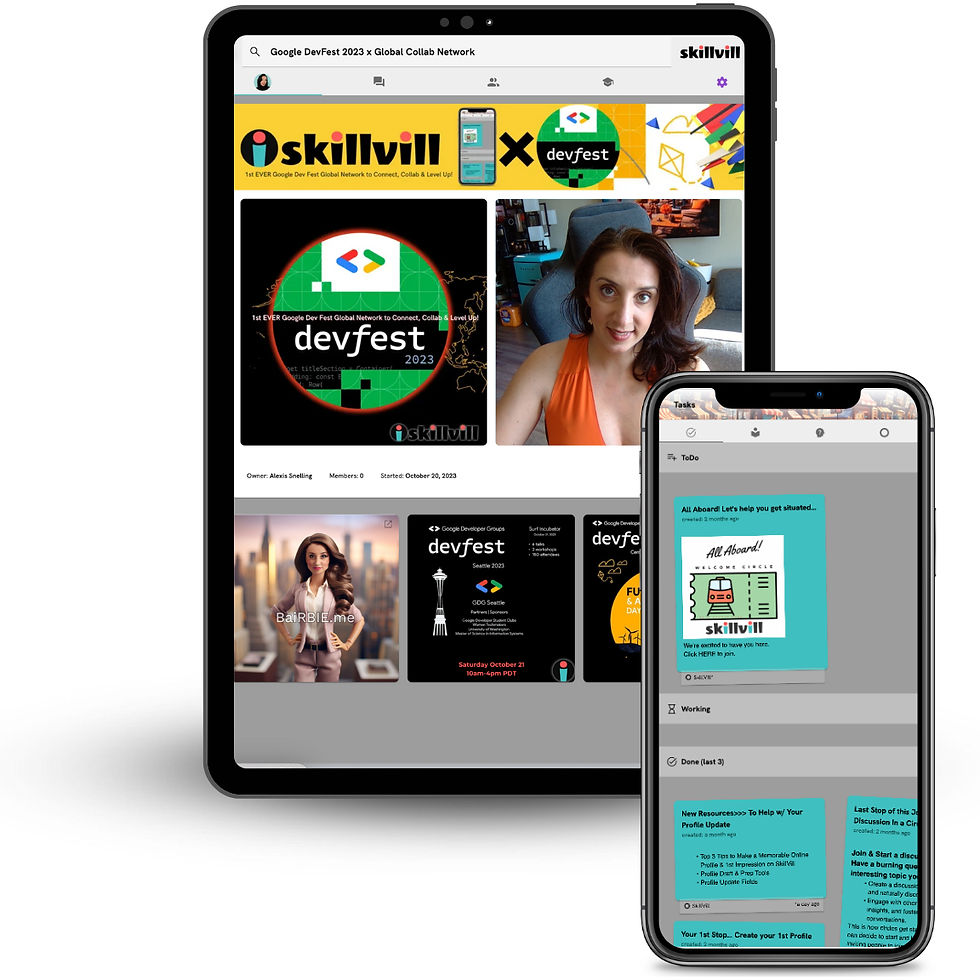Circle.so vs SkillVill
- Alexis Snelling
- Jul 31
- 4 min read
Updated: Oct 1
Beyond the "Complete Home": Why Skill-Based Communities Need More Than a Centralized Platform
Circle.so has emerged as a powerful contender in the online community space, positioning itself as the "complete community platform" for creators. It promises to build a home for your community, events, and courses—all under your own brand. And for many creators, it delivers on this promise exceptionally well. By unifying discussions, courses, and live events in a single, branded environment, Circle offers a streamlined, centralized experience that is a significant step up from a fragmented collection of tools.
However, when compared to a "next-generation social network" specifically designed for actionable skills, peer-to-peer feedback, real-time collaboration, and easy-to-use AI search, Circle's inherent design reveals some key limitations. While it is an outstanding tool for creating a curated, creator-led home, it is not architected to be a dynamic, user-driven ecosystem.
Here’s a breakdown of why a platform like Circle might not fully support an active, peer-to-peer, skills-based environment, and how SkillVill provides an alternative.
1. Design Philosophy: The Creator’s Hub vs. The Collaborator’s Ecosystem
Circle is fundamentally built around the creator's brand. Its structure of "Spaces" and "Posts" is a familiar and effective way to organize content, manage discussions, and host resources for your members. The platform's value proposition is centered on the community host's ability to curate the experience.
The Problem with Silos: Traditional communities like Circle are siloed to their members and the curated partners of the community owner. Connections and opportunities are limited to those within that specific channel.
How SkillVill was built better: SkillVill’s core architecture is not a series of spaces, but an interconnected network of skills, projects, and users. It’s designed around the individual member’s journey of skill acquisition and application. This enables connections and opportunities to be found outside their immediate channel and across the entire social network on SkillVill. It provides a hybrid model of curated content within a community and truly globally aligned connections in real time.
2. Peer-to-Peer Feedback and Skill Validation
While Circle’s commenting and discussion features are robust for general engagement, they lack the specific tools needed for granular, context-specific feedback on skill outputs. A simple post-and-comment model is great for Q&A, but it's not optimized for structured critique of a coding project, a design portfolio, or a business case study.
How SkillVill was built better: SkillVill integrates "Skill Badges" tied to verifiable project completions and peer endorsements on specific deliverables. Its "Code Review Module" allows for line-by-line feedback on programming projects, and the "Design Critique Canvas" enables direct annotations on design files. Every piece of feedback is tied to a specific skill within a user's profile, building a verifiable "Skill Ledger" that goes far beyond a simple list of interests. It's a system built for proof of skill, not just discussion.
3. Real-Time & Spontaneous Networking Challenges
Circle excels at facilitating planned interactions through scheduled events, live streams, and course modules. While this is crucial for building a community around a brand, its core design isn't optimized for the spontaneous, ad-hoc formation of temporary teams around immediate, often unpredictable, needs. The focus is on gathering people into a branded space, not on instantly matching them based on a "just-in-time" problem.
How SkillVill was built better: SkillVill features a "Real-time Collaboration Engine" for "micro-cohorts" and "flash teams". Users can post "Skill Bounties" or "Problem Pings" with immediate needs. The system uses a dynamic matching algorithm to instantly suggest collaborators based on real-time availability and complementary skills, facilitating those "I'm stuck on this Python problem right now, who can help me for 15 minutes?" moments. This is a crucial shift from passive, planned engagement to active, spontaneous problem-solving.
4. AI Integration (A Tool vs. An Engine)
Circle is beginning to incorporate AI features to enhance the creator experience, such as AI-powered content creation or post summarization. This makes the platform more efficient for the host. However, its AI functions as a tool
on top of the existing structure—it doesn't fundamentally change the way the community operates or connects.
How SkillVill was built better: SkillVill's "Contextual AI Search" is its engine. It allows users to ask open-ended questions like, "How do I fix this specific bug in React, and who can walk me through it in the next hour?". The AI then cross-references real-time availability and demonstrated skill proficiency from project work to suggest ideal mentors or collaborators. Its "Proactive Skill Navigator" AI continuously analyzes a user's engagement and feedback to identify emerging skill gaps and recommend highly personalized "Learning Sprints" before the user even realizes a need.
5. Business Model and Value Proposition
Circle’s monetization model is heavily geared towards the creator's business. Its feature set supports creators selling memberships, courses, and events. The value is generated by the host. A skill-centric network, however, derives its value from the collective output of its users.
How SkillVill was built better: The platform's value is created by the peer-to-peer interactions, projects, and skill growth. Monetization could come from micro-gigs, validated skill assessments, or paid peer mentorship—all of which are tied directly to user value, not just creator content. This shifts the value proposition from a creator's product to a community's collective intelligence and productive output.
In Essence:
Circle is an outstanding "home" for a branded community, providing a single, clean platform for creators to organize and deliver content, events, and discussions. It's a mature and robust solution for building and managing a centralized hub.
However, the vision of a truly active, peer-to-peer, skills-based network requires a different kind of platform—one that is built not just for the creator, but for the user. It requires a dynamic, performance-oriented, and AI-driven infrastructure that goes beyond traditional community management tools. It's about shifting from primarily content consumption and discussion to skill application, validation, and real-time collaborative problem-solving.
You're invited to ... Stop by any week to our FREE Skills-Based Social Net-Worth-ing online meet-up HERE: https://luma.com/redefinepossible
Join our SkillVill WAITLIST
Help us build a skills based social network together! We need to show the community is ready for launch. You can make a difference right now by joining the WAITLIST and hear when we launch to our 1st Skills-Based Social Channel together
Learn how to move your community or host your own channel for your neXt event, workshop, program or peer collab!





Comments